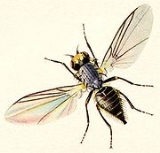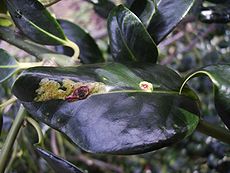
Agromyzidae
Encyclopedia
The family Agromyzidae is commonly referred to as the leaf-miner flies, for the feeding habit of larva
e, most of which are leaf miner
s on various plants.
A worldwide family
of approximately 2,500 species.The species are small, some with wing length of 1 mm. The maximum size is 6.5 mm. Most species are in the range of 2 to 3 mm.
Adult agromyzids can be recognized by the distinctive sclerotization
of the head. The upper part of the frons
, above the ptilinal suture
(known as the frontal vitta) is lightly sclerotized and lacks seta
e, while the lower part of the frons and the dorsal area of the head tends to be much more heavily sclerotized and setaceous. Thus the frontal vitta often forms a distinctive patch on the head, different in colour and texture to the rest of the head. The compound eyes are usually oval and fairly small although in some species they are larger and more circular.
 The wings
The wings
are usually hyaline
although those of a few tropical species have darker markings. A few species, including all Agromyza
spp, are capable of stridulation
, possessing a "file" on the first abdominal
segment and a "scraper" on the hind femur
.
Agromyzidae larvae are phytophagous, feeding as leaf miners, less frequently as stem miners or stem borers. A few live on developing seeds, or produce galls. The biology of many species is as yet unknown. There is a high degree of host specificity
, an example being Phytomyza ilicis
, the Holly leaf miner that feeds on no other species.
A number of species attack plants of agricultural or ornamental value, and are therefore considered pests.
Extract Google Books
on the UF
/ IFAS
Featured Creatures Web site
Larva
A larva is a distinct juvenile form many animals undergo before metamorphosis into adults. Animals with indirect development such as insects, amphibians, or cnidarians typically have a larval phase of their life cycle...
e, most of which are leaf miner
Leaf miner
Leaf miner is a term used to describe the larvae of many different species of insect which live in and eat the leaf tissue of plants. The vast majority of leaf-mining insects are moths , sawflies and flies , though some beetles and wasps also exhibit this behavior.Like Woodboring beetles, leaf...
s on various plants.
A worldwide family
Family (biology)
In biological classification, family is* a taxonomic rank. Other well-known ranks are life, domain, kingdom, phylum, class, order, genus, and species, with family fitting between order and genus. As for the other well-known ranks, there is the option of an immediately lower rank, indicated by the...
of approximately 2,500 species.The species are small, some with wing length of 1 mm. The maximum size is 6.5 mm. Most species are in the range of 2 to 3 mm.
Adult agromyzids can be recognized by the distinctive sclerotization
Sclerite
A sclerite is a hardened body part. The term is used in various branches of biology for various structures including hardened portions of sponges, but it is most commonly used for the hardened portions of arthropod exoskeletons....
of the head. The upper part of the frons
Frons
Frons is the term used to describe the frontal area of an insect's head. It covers the upper part of the face above the clypeus and below and between the antennae. It supports the pharyngeal dilator muscles and usually bears an ocellus . The term itself is derived from the Latin frons "forehead"....
, above the ptilinal suture
Schizophora
Schizophora is a section of true flies containing 78 families, which are collectively referred to as muscoids, even though - technically - the term "muscoid" should be limited to flies in the superfamily Muscoidea; this is an example of informal, historical usage persisting in the vernacular...
(known as the frontal vitta) is lightly sclerotized and lacks seta
Seta
Seta is a biological term derived from the Latin word for "bristle". It refers to a number of different bristle- or hair-like structures on living organisms.-Animal setae:In zoology, most "setae" occur in invertebrates....
e, while the lower part of the frons and the dorsal area of the head tends to be much more heavily sclerotized and setaceous. Thus the frontal vitta often forms a distinctive patch on the head, different in colour and texture to the rest of the head. The compound eyes are usually oval and fairly small although in some species they are larger and more circular.

Insect wing
Insects are the only group of invertebrates known to have evolved flight. Insects possess some remarkable flight characteristics and abilities, still far superior to attempts by humans to replicate their capabilities. Even our understanding of the aerodynamics of flexible, flapping wings and how...
are usually hyaline
Hyaline
The term hyaline denotes a substance with a glass-like appearance.-Histopathology:In histopathological medical usage, a hyaline substance appears glassy and pink after being stained with haematoxylin and eosin — usually it is an acellular, proteinaceous material...
although those of a few tropical species have darker markings. A few species, including all Agromyza
Agromyza
Agromyza is a genus of flies belonging to the family Agromyzidae. The adults of these flies can be recognised by the presence of stridulatory files on the first two abdominal tergites in both males and females...
spp, are capable of stridulation
Stridulation
Stridulation is the act of producing sound by rubbing together certain body parts. This behavior is mostly associated with insects, but other animals are known to do this as well, such as a number of species of fishes, snakes and spiders...
, possessing a "file" on the first abdominal
Abdomen
In vertebrates such as mammals the abdomen constitutes the part of the body between the thorax and pelvis. The region enclosed by the abdomen is termed the abdominal cavity...
segment and a "scraper" on the hind femur
Arthropod leg
The arthropod leg is a form of jointed appendage of arthropods, usually used for walking. Many of the terms used for arthropod leg segments are of Latin origin, and may be confused with terms for bones: coxa , trochanter , femur, tibia, tarsus, ischium, metatarsus, carpus, dactylus ,...
.
Agromyzidae larvae are phytophagous, feeding as leaf miners, less frequently as stem miners or stem borers. A few live on developing seeds, or produce galls. The biology of many species is as yet unknown. There is a high degree of host specificity
Host (biology)
In biology, a host is an organism that harbors a parasite, or a mutual or commensal symbiont, typically providing nourishment and shelter. In botany, a host plant is one that supplies food resources and substrate for certain insects or other fauna...
, an example being Phytomyza ilicis
Holly leaf miner
Phytomyza ilicis, the holly leaf miner, is a fly whose larvae burrow into leaves of the holly tree leaving characteristic pale trails or leaf mines...
, the Holly leaf miner that feeds on no other species.
A number of species attack plants of agricultural or ornamental value, and are therefore considered pests.
Species Lists
- West Palaearctic including Russia
- http://www.nearctica.com/nomina/diptera/dipa.htm#anchor410774 Nearctic
- Australasian/Oceanian
- Japan
Identification
Literature- Spencer, K.A. Agromyzidae (Diptera) of Economic importance Series Entomologica. Volume 9. Dr. W. Junk bv The Hague. D. Gld. 110.-. xii + 418 p.
Extract Google Books
- Darvas, B., M. Skuhravá and A. Andersen, 2000. Agricultural dipteran pests of the palaearctic region. In: László Papp and Béla Darvas (eds), Contributions to a manual of palaearctic Diptera (with special reference to flies of economic importance), Volume 1. General and applied dipterology, Science Herald, Budapest: 565-650.
- Frick, K.E., 1952. A generic revision of the family Agromyzidae (Diptera) with a catalogue of New World species. University of California Publications in Entomology 8: 339-452. Berkeley and Los Angeles.
- Spencer, K.A., 1987. Agromyzidae. In: J.F. McAlpine, B.V. Peterson, G.E. Shewell, H.J. Teskey, J.R. Vockeroth and D.M. Wood (eds): Manual of Nearctic Diptera 2. (Researach Branch Agriculture Canada, Monograph 28); Minister of Supply and Services Canada: 869-879.
- Braun, M.R., Almeida-Neto, M., Loyola, R.D., Prado, A.P. & Lewinsohn, T.M. "New Host-Plant Records for Neotropical Agromyzids (Diptera: Agromyzidae) from Asteraceae Flower Heads"
External links
on the UF
University of Florida
The University of Florida is an American public land-grant, sea-grant, and space-grant research university located on a campus in Gainesville, Florida. The university traces its historical origins to 1853, and has operated continuously on its present Gainesville campus since September 1906...
/ IFAS
Institute of Food and Agricultural Sciences
The University of Florida’s Institute of Food and Agricultural Sciences is a federal-state-county partnership dedicated to developing knowledge in agriculture, human and natural resources, and the life sciences, and enhancing and sustaining the quality of human life by making that information...
Featured Creatures Web site

